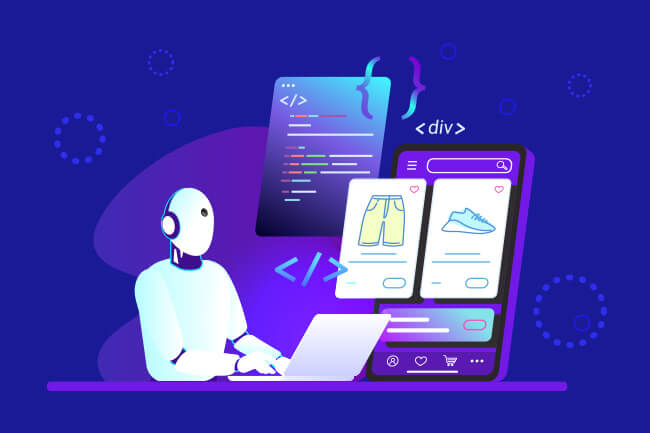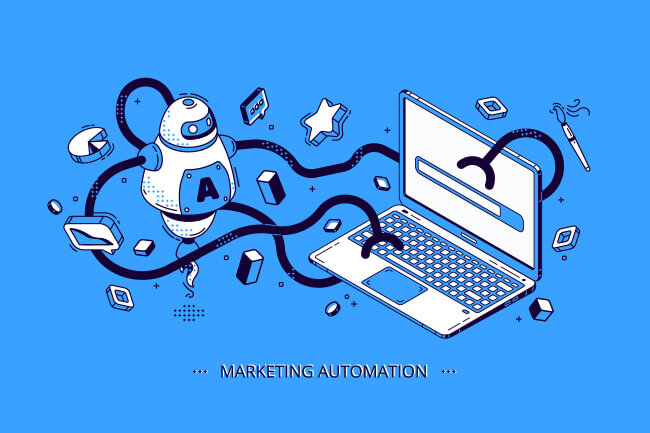AI and web design & development are closely intertwined, reshaping the way websites are created and operated. AI-driven tools automate design processes, generating layouts and content tailored to user preferences.
These systems also enhance personalization by analyzing user behavior and optimizing content in real-time, boosting engagement and conversions. Additionally, AI strengthens website security, identifying and mitigating threats promptly. In e-commerce, AI recommendation engines improve shopping experiences, increasing sales and customer satisfaction.
Voice and image recognition capabilities, powered by AI, make navigation more convenient. As AI and web development continue to evolve, they jointly shape the future of online experiences. As a result, website development agencies have had to rethink their strategies and ways of working.
In a survey of designers, 58% reported using AI for generating website imagery and media assets. Additionally, 50% utilize AI to craft entire web page designs, while 49% employ it to experiment with fresh design strategies and elements. Furthermore, 43% rely on AI to identify avenues for enhancing their designs.
How AI Is Revolutionizing Web Design And Development?
AI is revolutionizing web design and development in several transformative ways:
- Automated Design: AI-driven tools can analyze user behavior and preferences to automatically generate visually appealing and user-friendly website designs. This includes layout, color schemes, typography, and even content placement.
- Content Creation: AI can generate text, images, and videos, reducing the need for manual content creation. Chatbots and virtual assistants powered by AI can enhance user engagement by providing instant support on websites.
- Personalization: AI algorithms track user interactions in real-time and customize website content accordingly. This level of personalization improves user experience and increases conversion rates.
- Testing and Optimization: AI-powered analytics tools continuously monitor website performance, identify issues, and suggest improvements. This data-driven approach helps in optimizing the site for better results.
- Security: AI plays a vital role in website security by identifying and mitigating potential threats, such as malware and DDoS attacks, in real-time.
- E-commerce Enhancement: AI recommendation engines improve the shopping experience by suggesting products based on user behavior and preferences. This not only increases sales but also enhances customer satisfaction.
- Voice and Image Recognition: AI enables voice search and image recognition features on websites, making navigation more convenient and accessible.
- Efficiency and Cost Savings: AI automates repetitive tasks, reducing development time and costs. This allows web designers and developers to focus on more creative and strategic aspects of their work.
Ways AI Is Used In Web Design And Development
AI is employed in web design and development across various impactful ways:
- Automated Design: AI analyzes user preferences to automatically create visually appealing and user-friendly website designs, including layouts, colors, fonts, and content placement.
- Content Generation: AI generates textual content, images, and videos, reducing the need for manual content creation. It can also curate and manage content efficiently.
- Personalization: AI algorithms track user behavior and personalize website content in real-time, ensuring a tailored user experience that boosts engagement and conversions.
- Testing and Optimization: AI-powered analytics tools continuously monitor website performance, detect issues, and recommend improvements, helping in fine-tuning the site for optimal results.
- Security: AI plays a crucial role in website security, identifying and mitigating potential threats like malware and cyberattacks, ensuring the safety of the site and user data.
- E-commerce Enhancement: AI-driven recommendation engines improve the shopping experience by suggesting products based on user preferences, increasing sales and customer satisfaction.
- Voice and Image Recognition: AI enables voice search and image recognition on websites, simplifying navigation and accessibility.
- Efficiency and Cost Reduction: AI automates repetitive tasks, reducing development time and costs, allowing designers and developers to focus on creative and strategic aspects.
AI Tools For Web Design And Development
AI tools have become invaluable in web design and development, streamlining processes and enhancing outcomes.
Here are some notable AI tools used in this field:
- Wix ADI: Wix’s Artificial Design Intelligence (ADI) analyzes user inputs and automatically generates a personalized website design, layout, and content.
- Grid: Grid uses AI to design and develop websites, creating layouts and adjusting content based on user preferences and data.
- Adobe Sensei: Adobe’s AI, Sensei, offers advanced features in design and content creation, such as intelligent image cropping and personalized content recommendations.
- Frosmo: Frosmo utilizes AI to provide website personalization, enabling real-time content adjustments for each user.
- ChatGPT: AI-powered chatbots like ChatGPT offer conversational interfaces on websites, improving user engagement and support.
- Google’s AutoML Vision: This tool uses AI to analyze images on websites, offering image recognition capabilities and enhancing visual content.
- Wordtune: Wordtune employs AI to optimize website content, suggesting improvements in writing style, clarity, and tone.
Will AI Replace Web Designers And Developers?
AI won’t replace web designers and developers completely. It helps them work better.
Here’s why:
- Creativity: AI can do repetitive tasks but can’t think creatively like humans. Designers make websites look good and developers solve tricky problems.
- Understanding People: Good web design is about knowing how people think and feel. Designers get this, but AI just uses data.
- Complex Problems: Coding and solving tough web issues need human thinking. AI can help but can’t replace humans.
- Working with Clients: Designers and developers work closely with clients, adapting to their needs. AI can’t do this.
- Ethics: Web pros deal with moral stuff like privacy. AI can’t make moral choices.
- Learning: Tech changes fast. Humans keep up. AI can help but can’t lead.
- Testing: Humans find problems in websites AI misses.
How Can Web Designers And Developers Effectively Utilize AI?
Web designers and developers can make the most of AI by integrating it into their workflow in several ways:
- Automated Design Elements: Use AI tools to automate routine design tasks such as generating layout options, color schemes, and typography choices. This saves time and provides a starting point for creative customization.
- Content Generation: Employ AI-driven content generation tools to create textual content, images, and videos. Human designers can then refine and tailor this content to fit the website’s unique style and purpose.
- Personalization: Leverage AI algorithms to personalize website content and user experiences based on individual preferences and behaviors. Implement recommendation engines that suggest products, articles, or services to users in real-time.
- A/B Testing: Use AI-powered A/B testing tools to experiment with different design and content variations. Analyze user engagement data to determine which elements are most effective in achieving the desired goals.
- Security: Integrate AI-based security solutions to protect the website from cyber threats. AI can identify and respond to security breaches in real-time, enhancing overall safety.
- Chatbots and Customer Support: Implement AI-driven chatbots to provide immediate customer support and assistance. Chatbots can handle routine inquiries, leaving human designers and developers to focus on more complex tasks.
- Data Analysis: Utilize AI for in-depth data analysis to gain insights into user behavior and preferences. These insights can inform design and content decisions, ensuring a more user-centric approach.
- Voice and Image Recognition: Incorporate AI-powered voice and image recognition features into the website for enhanced accessibility and user interaction.
- SEO Optimization: Use AI tools to optimize website content for search engines. AI can identify relevant keywords, analyze competitors, and suggest improvements for higher search engine rankings.
- Efficiency: Automate repetitive tasks such as code generation and testing using AI. This frees up designers and developers to focus on more strategic and creative aspects of web development.
- Continuous Learning: Stay updated with the latest AI technologies and trends in web design and development. Attend training programs and webinars to understand how AI can be applied effectively.
- Ethical Considerations: Be mindful of ethical and privacy concerns when using AI. Ensure compliance with data protection regulations and prioritize user privacy and security.
The Future Of AI In Web Design And Development
The future of AI in web design and development holds exciting possibilities.
Here are some trends and predictions:
- Enhanced Personalization: AI will become even more proficient in understanding user preferences and behaviors, leading to hyper-personalized web experiences. Websites will adapt in real-time to individual visitors, increasing engagement and conversions.
- AI-Generated Content: AI-powered content generation will improve, creating high-quality text, images, and videos. This will reduce the time and effort required for content creation while maintaining quality.
- Voice and Visual Search: AI will play a crucial role in voice and visual search optimization. Websites will need to be optimized for voice-activated searches, and AI will aid in understanding and processing visual search queries.
- AI-Driven Chatbots: Chatbots will become more intelligent and human-like, providing exceptional customer support. They will handle complex inquiries and transactions, enhancing user satisfaction.
- Code Generation: AI will automate more coding tasks, simplifying web development. Developers may use AI to generate code based on design specifications, reducing coding errors and speeding up development.
- AI-Enhanced Design Tools: Design software will incorporate AI to assist designers further. AI algorithms will suggest design elements, layouts, and color schemes based on user preferences and design trends.
- Real-time Collaboration: AI-powered collaboration tools will enable seamless real-time collaboration among web development teams. This will improve workflow efficiency and project management.
- AI for Accessibility: AI will play a significant role in making websites more accessible. It will help in automatically generating alt text for images, providing captions for videos, and improving overall accessibility compliance.
- Security and Fraud Prevention:AI-driven cybersecurity tools will continuously monitor websites for threats and vulnerabilities, offering real-time protection against cyberattacks.
- Data-Driven Insights: AI will provide deeper insights into user data, enabling data-driven decision-making in web design and development. This will lead to more effective strategies and optimizations.
- Ethical AI: As AI becomes more integrated into web design and development, ethical considerations will gain prominence. Ensuring AI systems respect user privacy and adhere to ethical guidelines will be a priority.
- AI in E-Commerce: AI will transform the e-commerce landscape, enhancing product recommendations, personalized shopping experiences, and customer support, ultimately driving sales and customer loyalty.
Real-World Case Studies: Examples Of Successful AI-Integrated Websites
Several prominent companies are harnessing the power of AI in various ways:
Expedia: This popular travel-planning platform now incorporates conversational AI, allowing users to plan vacations through interactive chats. The app also generates smart lists of hotels and attractions to aid in trip planning.
Microsoft: Microsoft utilizes large language models like GPT-3 and GPT-4 to power its Bing search engine, enabling users to interact with search results conversationally. They’re also integrating AI across their software suite, including Word and Excel, and using AI to offer coding suggestions via GitHub Co-Pilot.
Duolingo: Duolingo employs GPT-4 to enhance language education. Duolingo Max provides detailed explanations for correct and incorrect answers, akin to a human tutor. Another feature allows students to interact with AI personas, practicing language skills in real-life scenarios.
Coca-Cola: The beverage giant collaborates with Bain & Company to employ ChatGPT for marketing and personalized customer experiences. AI assists in crafting tailored ad copy, images, and messaging.
Snap Inc (Snapchat): Snapchat integrates conversational AI into its social messaging app with “My AI.” This AI bot appears as a contact and assists users by answering questions or providing entertainment.
Slack: Slack offers an app powered by ChatGPT to assist users in managing workflows, boosting productivity, and facilitating communication within the collaborative workspace.
Octopus Energy: The UK-based energy supplier incorporates ChatGPT into customer service channels, handling a significant portion of customer inquiries and receiving high customer satisfaction ratings.
Cheggmate: This educational platform introduces Cheggmate, powered by GPT-4, to assist college students with assignments, expanding beyond its previous human specialist-based model.
Freshworks: Freshworks reports significant time savings in software application development, reducing the duration from 10 weeks to less than one week with ChatGPT’s help. ChatGPT can also generate code in multiple programming languages and serve as a coding tutor.
Udacity: Udacity employs GPT-4 to create an intelligent virtual tutor providing personalized guidance and feedback to online learners, aiding in problem-solving, explanations, and language translation.
Conclusion: Embracing Change And Cultivating Innovation
AI is rapidly reshaping the landscape of web design and development. It offers powerful tools for automating tasks, enhancing user experiences, and improving efficiency.
From chatbots and personalized content to automated coding and data-driven insights, AI is becoming an invaluable asset for web professionals. While it won’t replace designers and developers, it will empower them to work smarter and create more sophisticated, user-friendly websites. As AI continues to evolve, its role in web design and development is set to grow, promising an exciting future for the industry.




